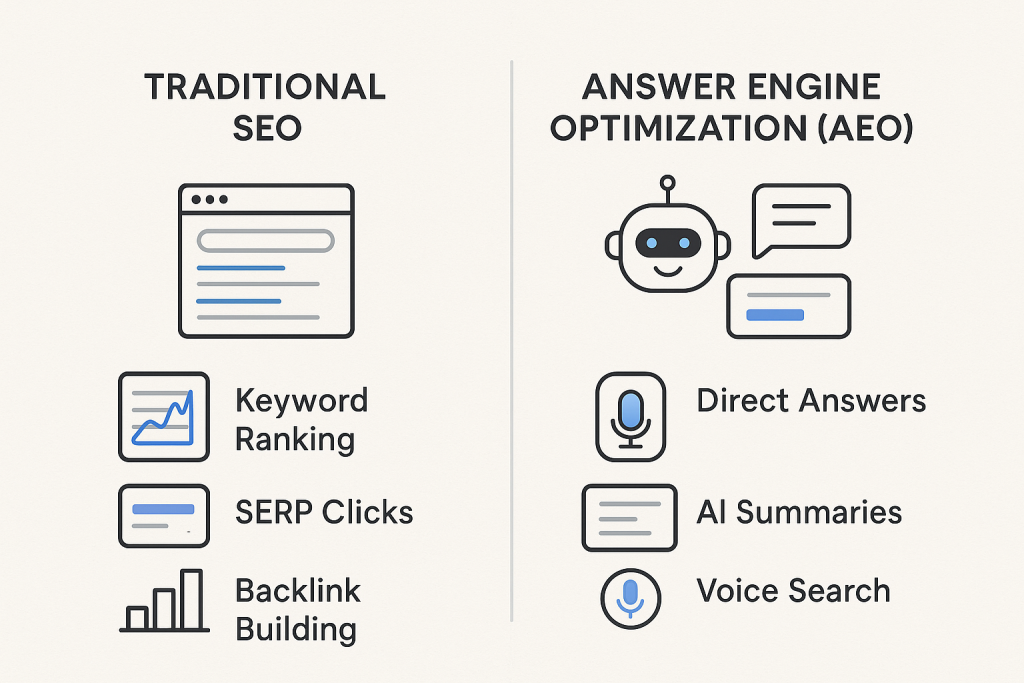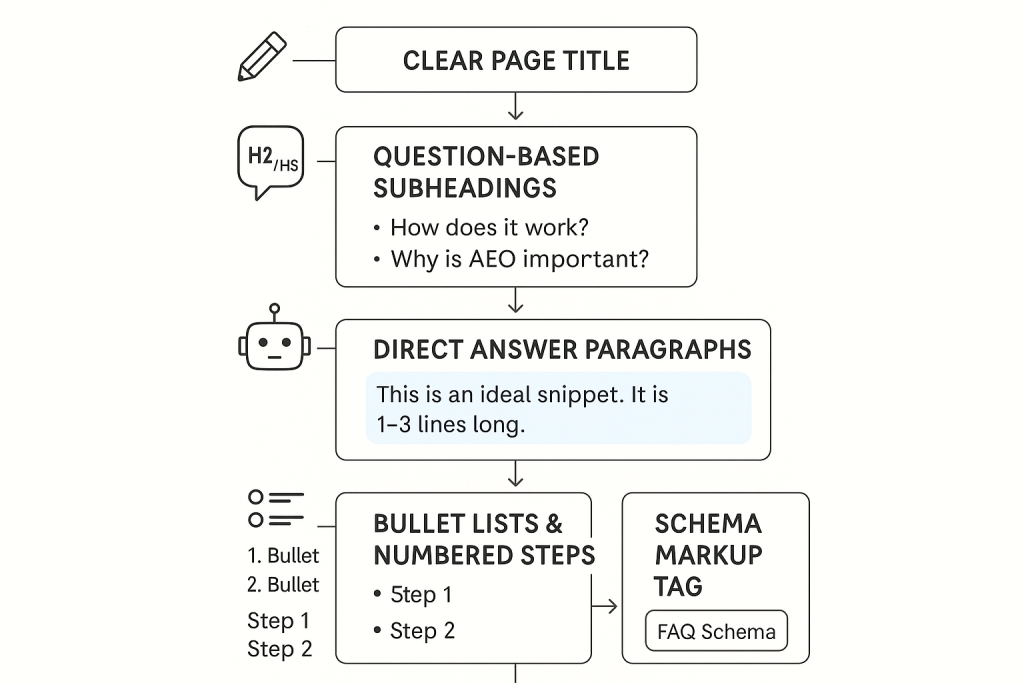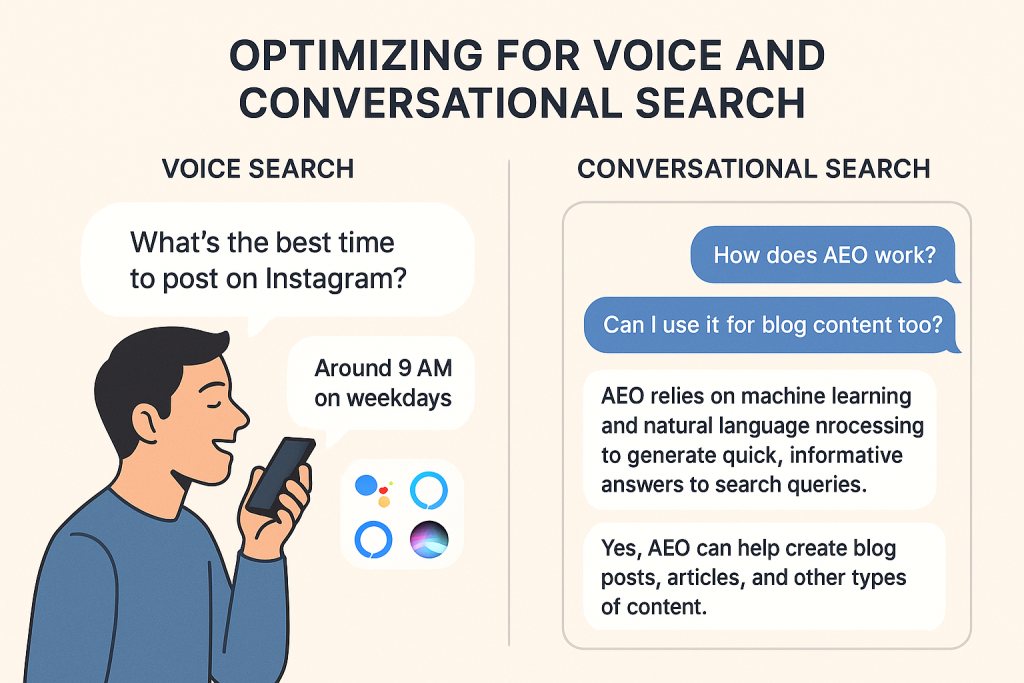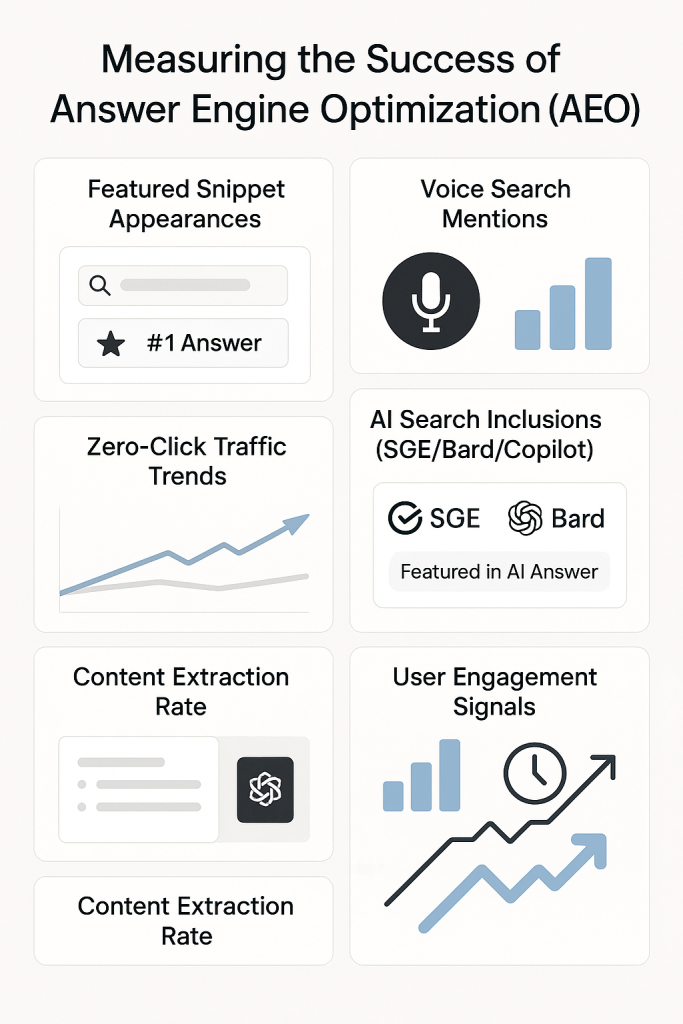
Most people turn to search engines expecting quick answers, not just a list of links. That shift in behavior has pushed platforms like Google, Bing, and ChatGPT to behave less like directories and more like actual answer engines. Answer Engine Optimization is the response to that change. It’s not a replacement for SEO, it’s the next step. If your content doesn’t directly answer what people are asking, chances are it’ll be overlooked.
In this guide, we’ll break down what AEO means, how it works, and what you can do to make sure your content gets selected, not just seen.
What Is Answer Engine Optimization (AEO)?
Answer Engine Optimization (AEO) is the process of customizing your content so that AI-driven platforms can understand, extract, and display it as a direct response to user queries. It’s how businesses ensure they’re not just showing up in search results, but answering the questions people are asking.
Unlike traditional search engine optimization, which focuses on better rankings, AEO focuses on how your content communicates information. Platforms like Google SGE, voice assistants, and tools such as ChatGPT don’t rely solely on ranking factors. They look for structured, conversational, and well-presented information they can pull instantly.
To make that happen, your content needs to be written for answer-focused content delivery. That includes using question-based content strategy, applying schema markup, and aligning with conversational search optimization practices.
Think of Answer Engine SEO as preparing your content to appear in featured answers, voice search results, or even zero-click searches. If your content isn’t built to be understood and presented by AI, it risks being completely overlooked. In a search experience increasingly led by machines, Answer Engine Optimization ensures your content still gets seen, trusted, and shared, even without a single click.
How Does AEO Differ from Traditional SEO (AEO vs SEO)?

At first glance, Answer Engine Optimization and traditional SEO services may look a bit similar, but they serve different goals. SEO services are all about improving rankings across search results. It works by targeting keywords, building backlinks, and optimizing pages for both search engines and users. The end goal of traditional SEO is getting higher rankings, more clicks, and more traffic.
But AEO plays by another set of rules. Instead of focusing solely on search rankings, it works around getting your content selected as the actual answer. Tools like Google Generative Search, voice assistants, and AI search platforms now pull content directly into their responses, skipping the click altogether.
In SEO, success often means being on page one. In AEO, success means being read aloud, quoted, or shown instantly. AEO content needs to be:
- Structured with schema markup
- Written in a conversational search optimization tone
- Aligned with zero-click search optimization strategies
- Clear enough for AI search ranking systems to extract effortlessly
Traditional SEO still matters. But without AEO, you’re not ready for the next wave of search, where AI decides what gets seen and what doesn’t. The two work together, but their roles in shaping visibility are no longer the same.
Why Is Answer Engine Optimization (AEO) Crucial in 2025?
Search behavior has changed. People want answers fast, and platforms are racing to deliver them without making users dig. That’s why Answer Engine Optimization isn’t optional anymore; it’s central to how content gets discovered.
In 2025, tools like Google SGE, ChatGPT, and other AI search platforms are shaping user experiences by pulling precise, context-rich answers straight from content. These tools don’t just scan for keywords; they look for relevance, structure, and clarity.
If your content isn’t built for zero-click search optimization, it likely won’t be featured. You’ll rank, maybe, but you won’t answer. And in this new reality, that distinction decides visibility.
How Do You Identify User Intent for Answer Engine Optimization (AEO)?
If your content doesn’t reflect what people are truly searching for, it won’t be selected as an answer, even if the writing is flawless. That’s why pinpointing user intent is the foundation of Answer Engine SEO.
Start by looking at how people naturally ask questions. Tools like Google’s People Also Ask, autosuggest, and AI systems such as ChatGPT can reveal the phrasing patterns behind real queries. It’s not just about keywords, it’s about the language users use. Most intent falls into three basic types:
- Informational: The user wants to understand or learn
- Navigational: The goal is to reach a specific destination or source
- Transactional: They’re looking to do something, sign up, buy, act
In AEO, informational intent takes priority. You’re not just answering questions, you’re anticipating the motivation behind them and responding clearly. Build content using a question-based content strategy. Structure it with clear prompts and direct answer-based content. This helps both AI and humans instantly understand the value of the page.
When your content mirrors how people search, it becomes easier for systems to extract and showcase your responses. That’s the real function of answer engine optimization.
What Tools Help in Discovering User Questions?
Understanding what your audience asks is the foundation of Answer Engine Optimization. You can’t optimize for answers unless you know the questions, and today, there are powerful tools designed to help with exactly that.
Here’s a list of Answer Engine Optimization tools that help uncover natural, intent-driven queries:
- Google’s People Also Ask Optimization: Shows commonly asked follow-up questions, ideal for identifying search behavior around a topic.
- Google Autocomplete: Helps spot trending queries by showing what users commonly type next.
- Answer the Public: Organizes real-world questions by modifiers like “what,” “why,” “can,” and “should.”
- Also Asked: Groups related queries into a logical flow, perfect for building structured answers.
- Semrush Keyword Magic Tool: Offers high-volume question keywords with filters for difficulty and intent.
- ChatGPT: Useful for testing how conversational queries might be phrased and answered.
- Ahrefs (Questions Report): Surfaces questions your audience types into search engines.
- Google Search Console: Let's you see actual search queries that brought users to your pages.
Each of these Answer Engine Optimization tools supports a stronger question-based content strategy and helps marketers in creating high-quality content optimized for AI search ranking. Using them regularly ensures your answers match real-world search behavior, a key element in effective answer engine optimization.
How Can You Categorize Questions by Intent?
Not every question carries the same weight or the same goal. In Answer Engine Optimization, knowing the type of question matters as much as the content of the answer. This is where intent categorization becomes essential. Broadly, user questions fall into three main types:
- Informational: These are curiosity-driven. The user wants clarity or an explanation. For example, “What is answer engine optimization?” or “How does schema help AI understand content?”
- Navigational: These signals aim to find a specific site, platform, or service. A user might type, “ChatGPT official website” or “Semrush login page.”
- Transactional: These signal readiness to act. The user wants to do something, like “Download AEO checklist” or “Hire AEO consultant.”
To categorize questions properly, start with Answer Engine Optimization tools like AlsoAsked or Answer the Public. Then label each query by likely intent based on phrasing and context. Doing this helps guide your question-based content strategy, ensuring that what you publish is useful not just to users, but to the AI search ranking systems that decide what gets shown.
How Should You Structure Content for Answer Engine Optimization?

To succeed with Answer Engine Optimization, how you say something is just as important as what you say. AI models and search platforms prefer content that’s easy to scan, logically ordered, and immediately useful. Here’s how to structure content that’s ready for AI search ranking:
Start with the question
Use clear, direct headings that reflect how users phrase their queries. This is the foundation of a solid question-based content strategy.
Follow with a snippable answer
In the first 1–2 lines under the heading, deliver a straight-to-the-point answer. Think featured snippet-style: concise, complete, and accurate.
Expand with context
After answering, build on it with supporting details, examples, or definitions to add depth and credibility, a key part of satisfying informational intent.
Use bullets or steps when needed
Lists make processes easier to follow and help with zero-click search optimization.
Include schema:
Use structured data like FAQ, HowTo, or Article markup to guide how platforms like Google SGE and voice assistants parse your page.
Use Question-Based Headings
Question-based headings are the backbone of effective Answer Engine Optimization. They make it easy for both users and AI platforms to understand what your content is about, and more importantly, where the answers are.
When someone types or speaks a query like “how does schema markup help SEO,” search engines are trained to find content that mirrors that structure. A heading that asks the same question increases your chance of being selected as the direct answer.
What are Snippable Content Blocks?
Snippable content blocks are compact pieces of text that directly answer a question in a format that AI systems can easily extract. They're essential for Answer Engine Optimization, especially when targeting zero-click search optimization and voice results. Search engines like Google SGE and tools such as ChatGPT look for short, clearly written answers they can display without sending users to another page. If your content isn’t formatted this way, it often gets skipped.
How to Write a Good Snippable Block?
- Use a clear heading, preferably a question
- Answer directly beneath the heading in one or two lines
- Stick to 40–50 words if possible
- Write in plain, human-friendly language
- Avoid filler or indirect phrasing
- Use bullet points for lists
- Use numbered steps for processes
- Use short paragraphs for definitions
- Use tables or comparisons where relevant
Where Should You Place Snippable Content?
Position your answer just below the question-based heading. This matches the inverted pyramid approach, delivering value up front, and makes your content easier for AI to interpret quickly.
How Can You Optimize for Voice and Conversational Search?

Voice and conversational queries are now a normal search behavior. As more people use smartphones, smart speakers, and AI assistants like ChatGPT and Alexa, optimizing for spoken queries has become a key part of Answer Engine Optimization.
Use Natural, Human Language
People don’t speak the way they type. Instead of "AEO definition," they might say, “What does AEO mean?” Focus on writing answers in a conversational tone, the same way you’d explain something to a colleague or client.
Focus on Long-Tail, Question-Based Queries
Voice searches are typically longer and more specific. Phrases like “how can I get my content into Google’s AI answers” are far more common than short keyword strings. Building your content around these types of questions helps align with both voice search optimization and question-based content strategy.
Answer Clearly and Quickly
Place direct answers in the first sentence or two below the heading. Keep it under 50 words when possible. This increases your chances of being featured in voice responses or zero-click search optimization formats.
Use Structured Formats
Tables, bullet points, and numbered steps help AI tools scan and extract answers. Pair this with schema markup for AEO to give machines the context they need to rank your content accurately.
Think Mobile First
Most voice searches happen on mobile. Ensure your content loads fast, reads well on small screens, and delivers value instantly, key for both users and AI search ranking systems.
When your content speaks like your reader and answers their questions directly, it becomes a natural fit for voice-driven platforms. That’s where modern visibility starts, with answers that sound as good as they read.
What Are Common Mistakes to Avoid in AEO?
Even with good content, simple missteps can keep it from showing up in answer engines. From unclear formatting to skipping structured data, these mistakes limit your chances of being featured. Avoiding them is key to making your answer-focused content visible, useful, and AI-ready.
Ignoring Structured Data
Skipping structured data is one of the biggest mistakes in Answer Engine Optimization. Without it, AI platforms struggle to understand the context of your content. Tools like Google SGE and voice assistants rely on schema markup to identify the purpose, structure, and relevance of your information. Adding formats like FAQ, HowTo, or Article schema makes it easier for machines to feature your answers. Structured data doesn’t just boost visibility, it guides answer engines toward the exact content users are looking for.
Using Excessive Keywords
Keyword stuffing doesn’t work with AI-driven search. In Answer Engine Optimization, clarity matters more than repetition. Overloading your content with keywords confuses both readers and machines. Tools like ChatGPT and Google SGE are built to understand meaning, not just match phrases. Instead of repeating the same terms, focus on writing naturally using variations and related questions.
Ignoring Mobile Optimization
If your content isn’t mobile-friendly, it’s missing a huge part of modern search behavior. Most voice search optimization happens on mobile devices, where users expect fast, readable, and direct answers. Pages that load slowly or have cluttered layouts often get skipped by both users and answer engines like Google Generative Search. A responsive design, clear formatting, and quick load times are essential for visibility.
How Do You Measure the Success of Answer Engine Optimization (AEO)?

Measuring success in Answer Engine Optimization is different from traditional SEO. It’s not only about ranking. It’s about how often your content is chosen as the answer.
1. Track Featured Snippet Appearances
Use tools like Semrush, Ahrefs, or Google Search Console to identify how often your content appears in zero-click search optimization results. A consistent increase suggests your structure is being recognized by search systems.
2. Monitor Impressions and CTR
Higher impressions with stable or rising click-through rates indicate your content is gaining visibility through AI search ranking. Even without a click, visibility in AI-driven snippets shows strong content alignment.
3. Assess Voice Search Presence
While exact tracking is still developing, test whether your content is read aloud by tools like Alexa or ChatGPT. If your answers are being spoken, it confirms your formatting works for voice search optimization.
4. Analyze On-Page Behavior
Metrics like bounce rate, scroll depth, and time on page help reveal if your answer-focused content is delivering what users want. High engagement means you're satisfying informational intent.
Conclusion-
Answer Engine Optimization isn’t just another SEO strategy. It’s a shift in how visibility works. As AI tools and voice search change how people find answers, content must be clear, structured, and aligned with real user intent. By focusing on direct responses, natural phrasing, and proper formatting, your content becomes easier for systems like Google SGE and ChatGPT to understand and feature. If your goal is to stay visible in search without relying on clicks, now’s the time to optimize for answers, because that’s what the future of search is built on.

Tarun Gupta, CEO of Brainpulse Technologies, is a prolific author and digital marketing specialist. His insightful writings span SEO, content marketing, social media strategy, and email campaigns, offering invaluable expertise to businesses worldwide. Tarun’s contributions continue to shape the digital marketing landscape, guiding success in multiple niches.